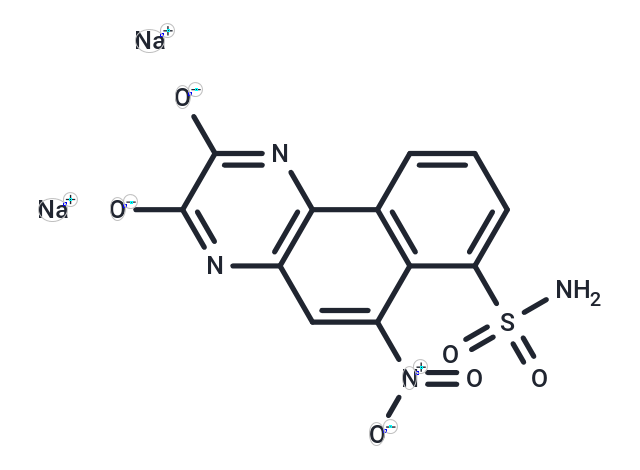Shopping Cart
- Remove All
 Your shopping cart is currently empty
Your shopping cart is currently empty

NBQX (FG9202) is a potent, selective and competitive AMPA receptor antagonist. Neuroprotective and anticonvulsant; active in vivo.

| Pack Size | Price | Availability | Quantity |
|---|---|---|---|
| 1 mg | $34 | In Stock | |
| 5 mg | $82 | In Stock | |
| 10 mg | $129 | In Stock | |
| 25 mg | $259 | In Stock | |
| 50 mg | $389 | In Stock | |
| 100 mg | $553 | In Stock | |
| 200 mg | $796 | In Stock | |
| 1 mL x 10 mM (in DMSO) | $89 | In Stock |
| Description | NBQX (FG9202) is a potent, selective and competitive AMPA receptor antagonist. Neuroprotective and anticonvulsant; active in vivo. |
| Alias | NBQX disodium salt, FG9202 |
| Molecular Weight | 336.28 |
| Formula | C12H8N4O6S |
| Cas No. | 118876-58-7 |
| Smiles | [Na+].[Na+].NS(=O)(=O)c1cccc2c1c(cc1nc([O-])c([O-])nc21)[N+]([O-])=O |
| Relative Density. | 1.6027 g/cm3 (Estimated) |
| Storage | Powder: -20°C for 3 years | In solvent: -80°C for 1 year | Shipping with blue ice. | |||||||||||||||||||||||||||||||||||
| Solubility Information | DMSO: 50 mg/mL (148.69 mM), Sonication is recommended. | |||||||||||||||||||||||||||||||||||
Solution Preparation Table | ||||||||||||||||||||||||||||||||||||
DMSO
| ||||||||||||||||||||||||||||||||||||

Copyright © 2015-2025 TargetMol Chemicals Inc. All Rights Reserved.